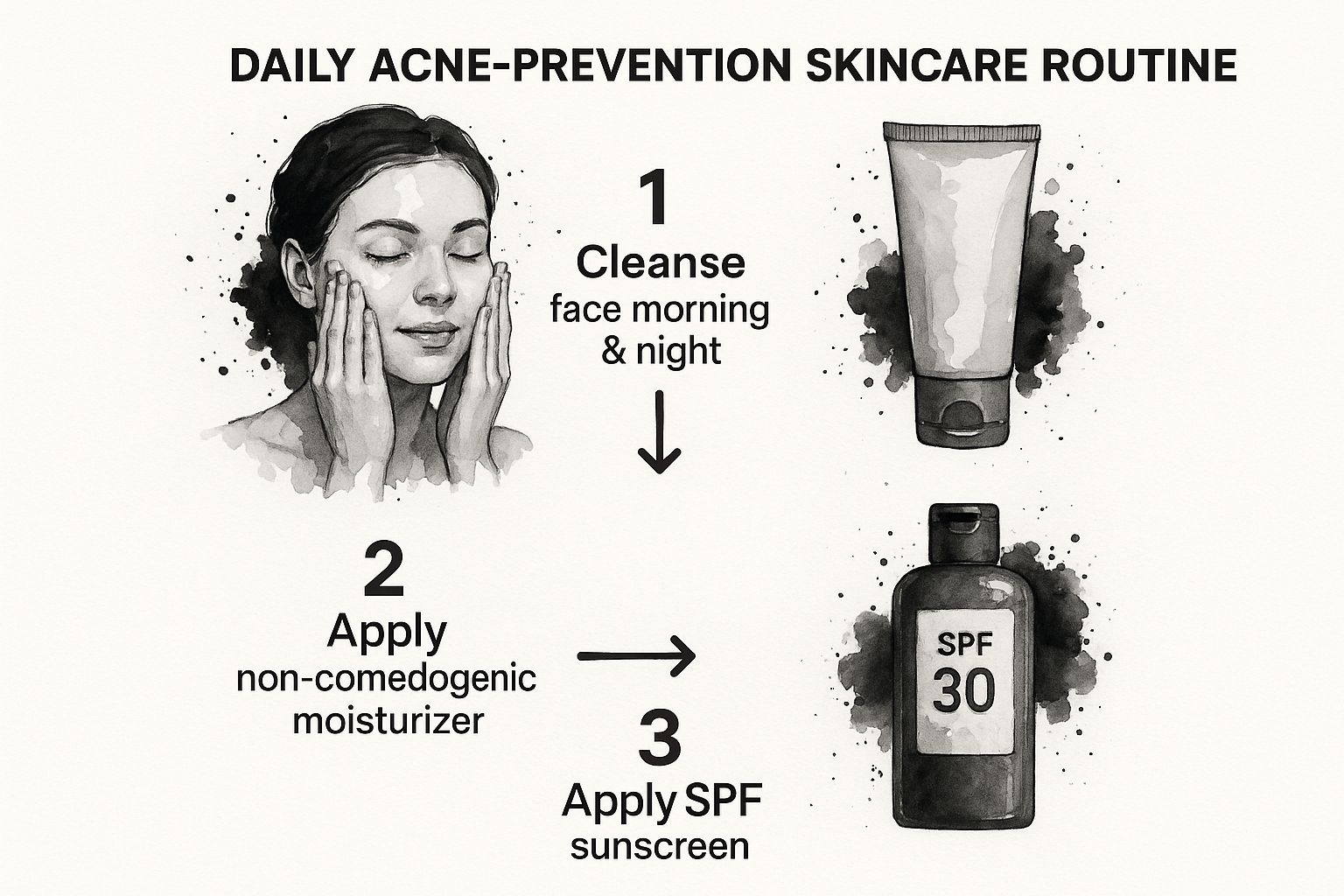
How to Prevent Acne Breakouts for Clearer Skin
To stop breakouts before they even start, you have to get to the root of the problem. It’s all about managing a few key things: excess oil, clogged pores, bacteria, and inflammation. A consistent routine paired with smart lifestyle choices is your best defense for keeping skin clear for the long haul.
Understanding What Causes Acne Breakouts
 Before you can really put a stop to breakouts, you need to know exactly what you’re up against. A pimple isn’t just some random spot that appears overnight; it’s the end result of a process that’s been brewing under your skin's surface, all starting inside your hair follicles, or pores.
Before you can really put a stop to breakouts, you need to know exactly what you’re up against. A pimple isn’t just some random spot that appears overnight; it’s the end result of a process that’s been brewing under your skin's surface, all starting inside your hair follicles, or pores.
At its core, acne is triggered by four main culprits working in tandem. When you understand how they operate, you can shift your focus from simply zapping pimples to preventing them from ever forming.
The Perfect Storm for a Pimple
Think of these four factors as the ingredients for a breakout:
- Too Much Oil (Sebum): Your skin produces a natural oil called sebum to keep itself moisturized. But sometimes, thanks to hormones or genetics, your oil glands go into overdrive, leaving your skin feeling greasy.
- Clogged Pores: When your skin cells don't shed properly, they can build up. These dead cells get mixed with all that extra oil, forming a plug that blocks the pore. To get the full picture, check out our guide on https://oliveskintherapy.com/post/what-causes-clogged-pores.
- Bacteria Overgrowth: A certain type of bacteria, Cutibacterium acnes (often just called C. acnes), absolutely loves this clogged, oily environment. It multiplies quickly, which sets off alarm bells for your immune system.
- Inflammation: In response to the bacteria party, your body sends in its defenses. This immune reaction is what causes the classic redness, swelling, and tenderness of a pimple.
If you’re dealing with acne, you're far from alone. Acne affects over 20% of the global population over the age of 16. In fact, its prevalence in young adults has jumped by about 25% in recent years.
Hormones, especially androgens, are major players here because they directly signal your skin to produce more oil. This is why breakouts are so common during puberty, around your menstrual cycle, or when you’re stressed. Knowing your specific triggers is key—for example, diving into understanding hormonal acne, its causes, and effective treatments can give you a huge advantage in your prevention strategy.
Building Your Daily Acne Prevention Routine
When it comes to getting clear skin, consistency is everything. I see so many people fall into the trap of only treating pimples after they’ve already surfaced, but that’s a constant game of catch-up. The real secret to preventing acne breakouts is creating a simple, sustainable daily routine that works ahead of the problem, keeping your pores clear and your skin balanced.
This isn't about an elaborate, 10-step ritual you'll abandon in a week. It's about consistently using the right products, in the right order, to build a foundation where acne simply struggles to form.
This quick visual guide breaks down the core of what a solid acne prevention routine looks like.

As you can see, it all comes down to three non-negotiable pillars: cleansing, moisturizing, and protecting your skin from the sun.
Your Morning And Evening Blueprint
Think of your routine in two parts: your morning routine is for protection, and your evening one is for treatment and repair.
Every morning, start with a gentle, pH-balanced cleanser. This will wash away the oil and gunk that accumulates overnight without stripping your skin’s protective barrier. Remember, aggressive scrubbing is your enemy—it just makes inflammation worse.
Next, follow up with a lightweight, non-comedogenic moisturizer. That’s just a fancy way of saying it won’t clog your pores. So many people with oily skin skip this, but that’s a huge mistake. When your skin gets dehydrated, it panics and produces even more oil to compensate.
Finally, the most important step of your morning is a broad-spectrum, oil-free sunscreen with at least SPF 30. Sun exposure not only worsens inflammation but also leads to those stubborn dark spots that linger long after a pimple is gone.
Your Guide to Acne-Fighting Ingredients
Once you’ve mastered the basics, you can start adding active ingredients to really target breakouts at their source. These are the workhorses of your routine. Choosing the right one can feel overwhelming, so this table breaks down the most effective over-the-counter options.
| Ingredient | What It Does | Best For | How to Use |
|---|---|---|---|
| Salicylic Acid | An oil-soluble BHA that gets deep into pores to dissolve oil and dead skin cell buildup. | Blackheads, whiteheads, and general pore congestion. | Start with a 2% cleanser or toner a few times a week, then increase as tolerated. |
| Benzoyl Peroxide | Kills the C. acnes bacteria that causes red, inflamed pimples and cysts. | Inflammatory acne (pustules, papules). | Begin with a low concentration (2.5% or 5%) as a spot treatment or short-contact wash. |
| Retinoids | Increases skin cell turnover, preventing dead cells from clogging pores in the first place. | All acne types, especially persistent comedones and preventing future breakouts. | Use a pea-sized amount at night only. Start with an OTC option like adapalene 2-3 times per week. |
Picking the right active ingredient for your skin type is a game-changer. Don't be afraid to start slow and see how your skin reacts before making it a daily habit.
Building the right routine isn't just about products. Evidence shows that a gentle skincare regimen, combined with other simple lifestyle choices, can significantly reduce breakout frequency and severity. Read the full research about these lifestyle findings on PubMed.
Sticking with these steps consistently is how you build a real defense against acne. For a more in-depth guide, check out our post on how to build a skincare routine tailored to your specific needs. And remember to be patient—it can easily take a few weeks for your skin to adjust and for you to start seeing results.
The Link Between Diet, Lifestyle, and Your Skin
 While a consistent skincare routine is your first line of defense, what you do every day matters just as much as what you put on your face. I can't tell you how many times I've seen clients with perfect routines still struggling with breakouts, only to discover the root cause was in their daily habits.
While a consistent skincare routine is your first line of defense, what you do every day matters just as much as what you put on your face. I can't tell you how many times I've seen clients with perfect routines still struggling with breakouts, only to discover the root cause was in their daily habits.
Your skin is a mirror, reflecting what's happening inside your body. That's why a holistic wellness approach is so crucial for getting to the bottom of persistent acne. It’s not about overhauling your entire life overnight, but about making small, smart choices that support your skin from the inside out.
How Your Diet Influences Your Skin
The whole "diet and acne" conversation has come a long way. We used to dismiss it, but now we know that while everyone has different food triggers, there are some common culprits worth looking at.
Foods with a high-glycemic index are a big one. Think sugary drinks, white bread, and processed snacks—anything that makes your blood sugar spike. That surge triggers a hormonal cascade that can crank up inflammation and oil production, basically creating a perfect storm for a breakout. It doesn’t have to be a massive change; even just swapping sugary cereal for oatmeal can make a difference.
Then there’s the dairy debate. For some people, dairy—especially skim milk—is a major breakout trigger. The theory is that hormones in milk can stimulate your oil glands. If you suspect dairy is causing issues, try cutting it out for a few weeks. It’s a simple experiment, and your skin will give you a clear answer.
A simple shift towards a diet rich in whole foods can make a world of difference. Focus on incorporating anti-inflammatory options like leafy greens, fatty fish, berries, and nuts to give your skin the building blocks it needs to stay clear and healthy.
Stress, Sleep, and Simple Hygiene Habits
Your daily habits have a direct, and often surprising, impact on your skin's behavior.
Stress Management Is Skin Management Ever notice a giant pimple appearing right before a big exam or an important meeting? It's not a coincidence. When you're stressed, your body pumps out cortisol, a hormone that tells your oil glands to go into overdrive.
Finding healthy ways to manage that stress is non-negotiable for clear skin. This could be anything that works for you:
- Daily Exercise: Even a 20-minute walk can lower cortisol levels and clear your head.
- Mindfulness: Just a few minutes of meditation or deep breathing can calm your entire nervous system.
- Setting Boundaries: Learning to say no and protecting your personal time is a powerful way to reduce chronic stress.
The Importance of Quality Sleep Sleep is when your body—and your skin—does its most important repair work. Skimping on sleep throws that whole process off, weakening your skin's barrier, increasing inflammation, and messing with your hormones. You really do need to aim for 7-9 hours a night to let your skin properly regenerate.
Finally, let's talk about the simple stuff we often overlook. Your phone screen, pillowcases, and makeup brushes are breeding grounds for bacteria. Get into the habit of wiping your phone down daily, changing your pillowcase at least twice a week, and washing your makeup brushes weekly. It’s a small effort that prevents you from constantly reintroducing breakout-causing gunk to your face.
Common Mistakes That Sabotage Your Skin
When you're desperate for clear skin, it's so easy to do things that actually make your breakouts worse. It sounds backward, I know, but sometimes our best intentions—and even some common advice—can backfire spectacularly.
Let's be real: the problem usually isn't that you're lazy with your skincare. It's often that you're doing too much of the wrong stuff. Learning what not to do is just as important as finding the right products.
Over-Exfoliating and Harsh Scrubbing
See a pimple, scrub the pimple. It’s an almost primal instinct, right? It feels like you’re actively fighting back. But this is probably one of the worst things you can do. Your skin has a delicate shield called the moisture barrier, and its job is to keep hydration in and bad bacteria out.
When you go to town with gritty physical scrubs or overuse powerful chemical exfoliants, you’re essentially tearing down that wall. A compromised barrier leads to red, angry, sensitive skin that's even more susceptible to breakouts. You're not healing the problem; you're creating a perfect storm for more acne.
The Myth of Skipping Moisturizer
This one's for everyone with oily skin. The idea of slathering on moisturizer when you already feel like an oil slick sounds insane. But here’s the thing: skipping it is a huge mistake that actually tricks your skin into producing more oil.
When your skin gets dehydrated, it panics and cranks up oil production to compensate. This kicks off a frustrating cycle of clogged pores and more breakouts. Using a lightweight, non-comedogenic moisturizer tells your skin, "Hey, we're good on hydration," so your oil glands can finally take a breather. Properly hydrated skin is balanced skin, and balanced skin is much less likely to break out.
Picking and Popping Your Pimples
I get it. It’s sitting there on your face, staring back at you in the mirror, just begging to be popped. But please, resist the urge. Squeezing a pimple almost always pushes some of that bacteria and gunk deeper into the pore, making the spot redder, more swollen, and ensuring it sticks around for much longer.
Every single time you pick, you're rolling the dice on permanent acne scars and post-inflammatory hyperpigmentation. Those are the stubborn dark spots that can haunt you for months long after the pimple is gone. Plus, the bacteria on your fingers can turn one little spot into a full-blown breakout.
Overloading on Active Ingredients
It's easy to get excited when you discover powerful ingredients like salicylic acid, benzoyl peroxide, and retinoids. You might think, "If I use them all at once, I'll get clear skin three times as fast!" Unfortunately, skincare doesn't work that way. It's a recipe for a seriously unhappy face.
Throwing everything at your skin at once will overwhelm it, leading to a world of irritation, peeling, and redness. When your skin is that stressed out, it can't heal itself properly, and your acne will likely look even worse. The key is to introduce one new active at a time. Start with a low concentration a couple of nights a week and let your skin adjust. This way, you can actually tell what’s helping and what’s hurting.
When to See a Dermatologist for Your Acne

Let's be honest, sometimes you can do everything right with your skincare routine and still feel like you're losing the battle against breakouts. If you've been consistent with over-the-counter products and your acne isn't budging, it's not a sign of failure—it's a sign you need to call in a specialist.
Knowing when to wave the white flag on at-home treatments is key to protecting your skin in the long run.
If your acne is leaving behind more than just frustration—think physical scars or a real blow to your confidence—it’s time. This is especially true if you're getting those deep, painful cysts or nodules that feel like they're lurking under the skin's surface and never come to a head. That kind of acne has a nasty habit of leaving permanent scars.
Along the same lines, if you’re noticing that every breakout leaves a dark spot or a little pit in its place, a professional can step in. They won't just help with the active acne; they'll also have a game plan for the damage already done. A professional can walk you through powerful options, and a good place to start learning is by exploring treatments like microneedling for acne scars.
Recognizing the Signs It's Time for Help
Think about scheduling an appointment if any of this sounds familiar:
- Your Routine Isn't Working: You’ve stuck with a solid over-the-counter regimen for 3-4 months, but you're seeing little to no change.
- The Acne is Deep and Painful: You're dealing with cystic acne—those hard, tender lumps that form deep under the skin.
- It's Spreading: Your breakouts aren't just on your face anymore. They're showing up on your chest, back, and shoulders, too.
- You're Seeing Scars: Indented scars or dark marks are sticking around for months after the pimple itself is long gone.
One of the biggest regrets I hear from clients is that they waited too long to see a professional. A dermatologist has access to treatments that are leagues beyond what you can get at the drugstore, helping to stop the acne cycle before it causes permanent damage.
The need for clear, effective strategies is more critical than ever, especially considering the rise in acne among women. Between 1990 and 2021, acne cases in women aged 15-49 shot up by 38%, a jump linked to modern shifts in diet, stress, and lifestyle. This trend, highlighted by a study featured in Dermatology Times, shows just how vital professional guidance on preventing acne breakouts has become.
What to Expect from Professional Treatments
Seeing a dermatologist completely opens up the playbook. They can diagnose the root cause of your acne and build a targeted treatment plan that's actually designed for your skin.
You'll gain access to prescription-strength options like topical retinoids (think tretinoin), which are far more potent than what you can buy over the counter and are incredible for speeding up cell turnover. If your acne is red and inflamed, oral antibiotics might be prescribed to tackle the bacteria and inflammation from the inside out.
For stubborn hormonal acne that loves to hang out on the jawline, a medication like spironolactone can be a true game-changer. It works by managing the hormones that send your oil production into overdrive. Just knowing these options are out there can give you the confidence to take that next step toward clear skin.
Answering Your Questions About Acne Prevention
Diving into the world of skincare can feel overwhelming, especially when you're trying to get a handle on acne. You can have the perfect routine mapped out, but questions always pop up. Am I doing this right? Is this normal? Let's clear up some of the most common questions I hear from people on their journey to clearer skin.
How Long Does a New Routine Actually Take to Work?
This is the big one, and the honest answer is: you need to be patient. You'll typically start to see real, noticeable improvements after about 4 to 6 weeks. Why that long? It lines up with your skin's natural cell turnover cycle—the time it takes for new skin cells to make their way to the surface as old ones are shed.
If you're using something more potent like a retinoid, which really gets in there and revs up that cell turnover process, you might be looking at closer to 3 months to see the full effect. The hardest part is sticking with it when you don't see results overnight. Trust the process.
A good thing to remember is that acne doesn't pop up in a day, and it won't vanish in one either. Giving your routine the time it needs to work is just as crucial as picking the right products in the first place.
Can My Makeup Be Causing My Breakouts?
Yes, it absolutely can. If you've ever dealt with a cluster of small, stubborn bumps after trying a new foundation, you've likely met acne cosmetica. It's a specific type of acne triggered by pore-clogging ingredients in makeup. Your first line of defense is to always check for products labeled "non-comedogenic" or "oil-free." That label means they've been formulated specifically to not block your pores.
But the product is just one piece of the puzzle. How you take it off is just as important.
- Never, ever sleep in your makeup. It’s a non-negotiable rule. Leaving it on overnight traps a day's worth of oil, dirt, and bacteria right where you don't want it.
- Double cleanse to get everything off. I always recommend starting with an oil-based cleanser or micellar water to break down the makeup, followed by your regular gentle cleanser. This ensures you're starting with a completely clean slate.
- Wash your tools weekly. Your makeup brushes and sponges are a paradise for bacteria. Cleaning them at least once a week stops you from smearing that buildup right back onto your fresh, clean skin.
Does Sweating From My Workout Make Me Break Out?
Sweat itself isn't the culprit, but the environment it creates is. When sweat mixes with the oil and dead skin cells already on your skin, it's a recipe for clogged pores. Throw in the friction from tight-fitting workout gear, and you've got the perfect storm for breakouts on your face, chest, and back.
The best thing you can do is work out with a clean face if possible. But what really matters is what happens after. As soon as you're done, hop in the shower and change into clean, dry clothes. If a shower isn't an option right away, at least use a gentle cleansing wipe on your face and other acne-prone areas to get the sweat and grime off before it has time to settle in.
How Much Does What I Eat Really Affect My Skin?
For a lot of us, diet plays a huge role. While everyone's skin has different triggers, a lot of research now points to a connection between certain foods and acne flare-ups. High-glycemic foods—think sugar, white bread, and other refined carbs—can send your blood sugar on a rollercoaster. This spike triggers a hormonal cascade that ramps up oil production and inflammation in the skin.
Dairy is another common trigger for some people. If you suspect your diet might be playing a part, try keeping a food diary for a few weeks to see if you can spot any patterns. Shifting your focus to a diet packed with whole foods like fruits, vegetables, and lean protein can often make a surprising difference in your skin's clarity.
At Olive Skin Therapy, we know that expert, personalized guidance is what truly leads to your best skin. If you're ready to move beyond guesswork and get a treatment plan built for your unique concerns—from active acne to scarring—book your consultation today. You can also learn more about our specialized facials and advanced treatments on our website.
